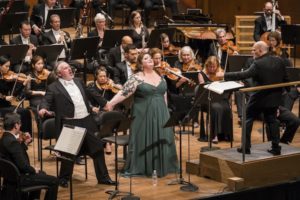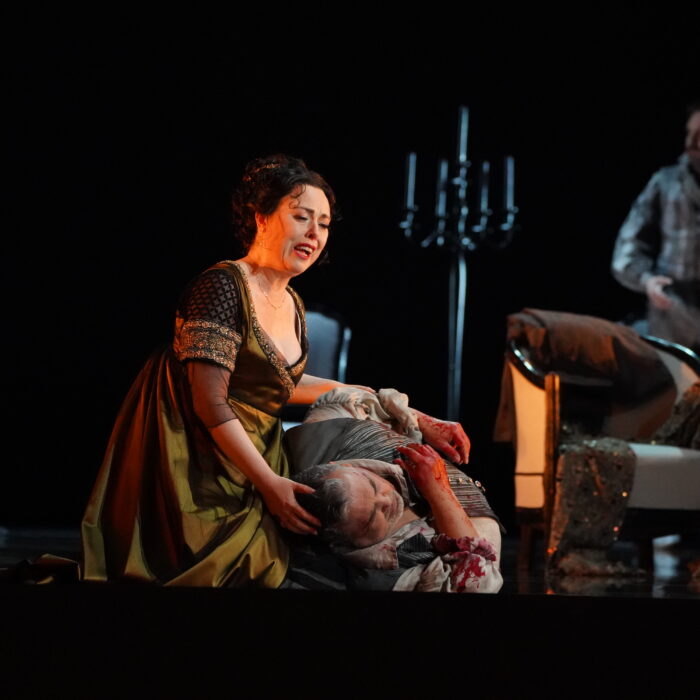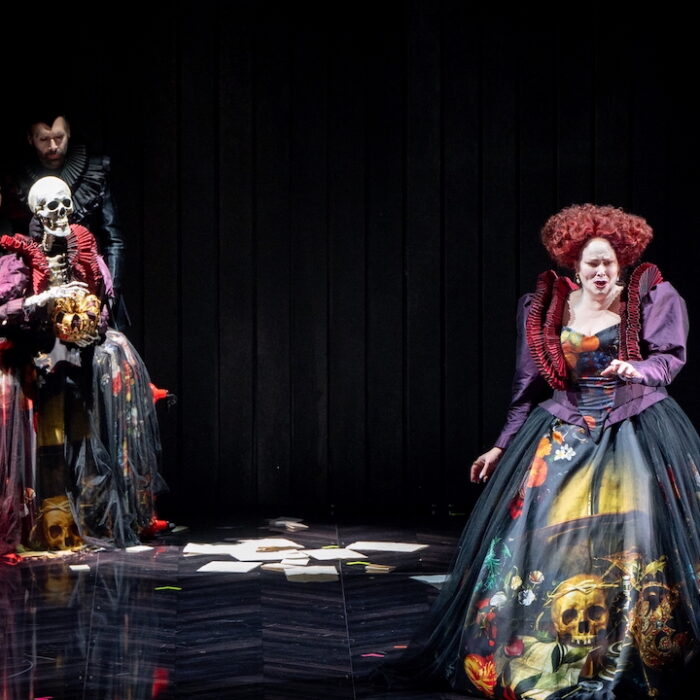
New York Philharmonic 2017-18 Review – Die Walküre: Jaap van Zweden & Soloists Deliver Sublime Rendition of Act One of Wagner Masterwork
By David SalazarIn 2018-19, Jaap van Zweden, the current Music Director Designate of the New York Philharmonic, will drop the Designate part of that label. And if the concert on Thursday, Feb. 15, 2018 is any indication, he is going to be providing audiences with some dazzling music for years to come.
In a series of concerts that kicked off on Valentine’s Day, van Zweden programmed two pieces that fit together beautifully.
An Ethereal Experience
First up was the New York Premiere of John Luther Adams’ “Dark Waves,” a sublime piece of music to be sure. The piece smothers you with a massive wave of sound that just builds and build, its tension coming from the sense of build with no resolution. Think Wagner’s “Tristan und Isolde” marrying a prolonged Rossini crescendo of one note. It will certainly transport you somewhere, though that isn’t all that clear. Those seeking melodic development or harmonic resolution might not be impressed (as one audience member seated nearby clearly wasn’t), but there is no doubt it is a piece of music capable of creating a unique and powerful experience.
But the real reason most people were in the hall was for the first Act of “Die Walküre” starring tenor Simon O’Neill, Heidi Milton, and John Relyea. And it was hard not to come away completely mesmerized by the experience.
Wagner on Steroids
Seeing an opera in the theater and in a concert is a completely different experience, mainly because the orchestra gets a chance to do things that it can’t simply due to its placement in the hall. With the soloist standing in front of the ensemble (and not behind it), van Zweden can emphasize certain orchestra colors without fearing that he might overpower or wash away the sound of a singer. One such example came at the climax of the scene, Siegmund’s “Siegmund heiss ich,” with the brass section getting a chance to simply explode with volume to extraordinary effect. This alone added heroic quality to the scene. Moreover, the halls resonance allowed for certain musical risks to be taken, such as a more agitated prelude and even greater accentuation on the strings. Orchestral swells were allowed to grow with greater dynamic range, starting off far quieter and growing more intensely (examples: the moments right before Siegmund pulls out the sword, the moments preceding Siegmund’s “Ein Schwert verhiess mein Vater,” the orgasmic coda to the act, or even the solo cello line that outlines the love between the two characters near the start of the act). I have to highlight the solo playing by Principal Cellist Carter Brey, whose playing delinated the burgeoning love between the two quite beautifully, taking each line delicately and building it one after another until it transformed into the gorgeous cello ensemble, fully fleshed and sublime.
It wasn’t perfectly etched, some sections spotty in execution, such as the accompaniment in “Winterstürme” where the orchestra and O’Neill didn’t seem to be together for lengthy portions, but it was thrilling in its sense of drive. Van Zweden imbued the entire Act with propulsiveness that made the hour fly by.
A Complex Hero
The approach also allowed his three soloists to shine through. O’Neill, while getting on in his years, is still a vocal marvel, his singing gorgeous throughout the night. He seemed overpowered at certain times near the start of the Act, but as it progressed he seemed to get stronger, delineating Siegmund’s own development. His voice is not the biggest (it might have been the smallest of the three), but his impeccable diction made it pierce through the orchestra effectively. He had the requisite heft when needed, as exemplified on his two iconic cries of “Wälse,” the second of which he held out for quite a long time. And he was fierce and powerful in the closing “aria,” “Siegmund heiss ich,” the singing growing and growing with each line until he climaxed on an extended A flat that he held out as long as he could.
But he was more interested in exploring a wider range of vocal colors throughout and his most arresting moments actually came in the sections you might not expect – the narrative he tells Hunding. He was entrancing as he told the story of his lost father and then the murdering of the villagers and his ensuing escape. You could feel fear, dread, anger, power, and exhaustion throughout this telling. While there were subtitles to supply the details, you could have followed the story just from listening to his singing, so powerful was his storytelling. And his “Winterstürme” was glorious in how he turned his voice into the most delicate of threads and practically sang it at a piano dynamic. It was tender and gentle, and surely the way to anyone’s heart. No heroism here, but simply romantic serenity.
Two Competing Forces
As Sieglinde, Heidi Melton was passionate and fiery, a far cry from the servant wife we often get. Her voice has a hard edge which one might associate more readily with a Brünhilde, but on this night she wielded it quite beautifully to dramatic and musically emotional effect. Her exchanges with Relyea’s Hunding were some of the most memorable of the evening as she snapped back at him with forceful tone in a manner one isn’t accustomed to seeing from a Sieglinde. This alone made you believe that she would fearlessly run away with a stranger at the end of the act. And this sense of power and strength was also present in other major moments, most notably as she told Siegmund his new name, her sound accented and purposeful. You’ve probably never heard so much certainty and poise from any other Sieglinde these days.
Her interactions with O’Neill ranged from intensely passionate to sweet and gentle, but she was compelling in her involvement when she wasn’t singing. There was not one instant where she wasn’t interacting in some manner with her colleagues, whether falling in love with O’Neill’s Siegmund or building hate for Relyea’s Hunding. Even if this is not the intent of a concert, it added to the presentation and emotional involvement one had with the singing on the evening.
As Hunding, bass Relyea possessed a humungous sound that resonated fiercly throughout David Geffen Hall. There was no ambiguity about how he saw Hunding, portraying as condescending, angry, and brimming with violence. He accented his phrases forcefully, wielding his sound like a weapon every time he opened his mouth. It contrasted beautifully with the gentler quality of O’Neill’s Siegmund, but played off well with firmness of Melton’s interpretation.
As the act came to an end, the audience erupted into intense applause (you can check it out on OperaWire’s Instagram page), which was undeniably merited. It was an exciting, sublime and revelatory performance. Let’s hope van Zweden has more Wagner or operatic performances planned for 2018-19.
Thanks to the New York Philharmonic’s YouTube channel, which includes the streaming of certain performance, you can actually check the concert out below:


